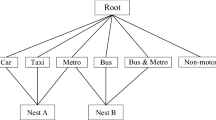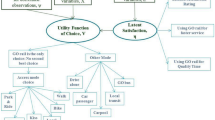Abstract
The logit modeling methodology is applied to include transit access mode choices in conjunction with the automobile vs. transit travel choice decision. The practical problems that arise when the choice set expands beyond two alternatives are identified and addressed. In particular, the complexities that must be resolved in order to use ULOGIT or a similar program include the definition of independent choices (the Independence of Irrelevant Alternatives Property (IIA)), a sequential binary or multinomial logit model (MNL) structure, specification and testing of variables, and the potential for transferring the model to new areas for transportation planning purposes. It was found that the available options cannot be reduced to a single modeling strategy. However, the analysis showed certain concepts which can reduce the uncertainties in related applications of the logit model. It was determined that as many independent choices as possible should be hypothesized and tested for inclusion in the model, but the IIA must be carefully considered because it limits the number of choices that can be represented. Although binary calibration techniques are conceptually appealing, the large number of calibrations for studies involving more than three alternatives suggests that the MNL approach is most practical. Application of the MNL model requires that not only must variables be selected that best explain choice, but they must also be placed in the disutility function of the specific mode or modes to which they are most unique. Finally, it was shown that if choice sets and homogeneous market segments are properly defined, the models can be transferred among different urban areas even though the urban areas exhibit different aggregate characteristics. All observations lead to the general conclusion that the logit modeling methodology can now best be advanced with implementation experience.
Similar content being viewed by others
References
Charles River Associates, Inc. (1976). Disaggregate Travel Demand Models Project 8–13: Phase I Report, Vol. II, National Cooperative Highway Research Program, Cambridge, MA.
Demetsky, M. J., Robertson, R. N. and Jalette, R. E. (1978). “Evaluation of the Greenwood Drive Fringe Parking Facility,” Virginia Highway and Transportation Research Council, VHTRC 78-R45, Charlottesville, Virginia.
Kavak, F. C. and Demetsky, M. J. (1975a). “Express Bus-Fringe Parking Planning Methodology”, Virginia Highway and Transportation Research Council, Charlottesville, Virginia, Final Report, VHTRC 75-R60.
Kavak, F. C. and Demetsky, M. J. (1975b). “Behavioral Modeling of Express Bus-Fringe Parking Decisions,” Transportation Research Record 534: 10–23.
McFadden, D. (1974), “The Measurement of Urban Travel Demand,” Journal of Public Economics 3: 303–328.
Spear, Bruce D. (1977), “Applications of New Travel Demand Forecasting Techniques to Transportation Planning — A Study of Individual Choice Models,” DOT/FHWA.
Stopher, P. and Meyburg, A. (1975). Urban Transportation Planning and Modeling. Lexington: Heath.
Author information
Authors and Affiliations
Rights and permissions
About this article
Cite this article
Demetsky, M.J., Korf, J.L. Modeling park 'n ride and kiss 'n ride as submodal choices. Transportation 8, 409–426 (1979). https://doi.org/10.1007/BF00167992
Issue Date:
DOI: https://doi.org/10.1007/BF00167992




